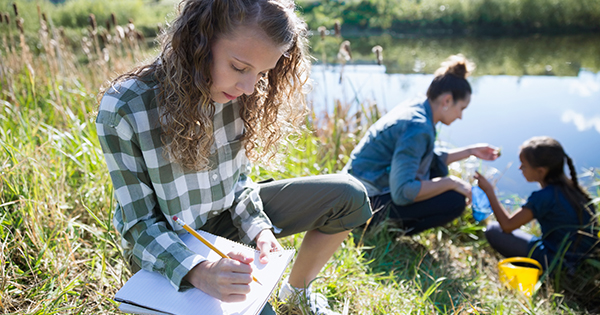
Summer allows parents a bit more time to engage with their kids and participate in experiments that they can check on every day together. Completing science experiments throughout the summer will help students to keep engaged in academic inquiry and learn more about science during their months off.

The experiments outlined below can be done easily (and inexpensively) from home. They require materials that many people may already have in their kitchens or that are easy to find.
Homemade candy crystals
While this project will take some time to set up and achieve results, students will enjoy the ability to grow crystals they can eat when the process finishes.
Ingredients: Pan to boil water, glass jar to hold crystals, sugar, pencil, string.
Process:
- Tie the string to the pencil and make sure the string doesn’t reach all the way down to the bottom of the jar.
- Heat a cup of water until it boils.
- Stir 3 cups of sugar, 1 spoonful at a time, into the boiling water.
- When the sugar is dissolved, add in a few drops of food coloring.
- Pour the mixture into a very clean jar
- Put the pencil on top of the jar with the string hanging down the middle.
- Let the sugar crystals grow around the string until they are the desired size.
- Allow the kids to chart the sizes and changes and enjoy (eating) the final product.
Shaving cream rain clouds
With afternoon storms prevalent in (most) states in the summer, it’s a great time to teach students about precipitation.
Ingredients: Jar of water, food coloring, shaving cream
Process:
- Fill a jar with water.
- Spray some shaving cream on top. Explain to the children that this is like a cloud in the sky.
- Drop little droplets of food coloring onto the top of the cloud.
- Explain that this is how rain builds up in clouds and eventually falls back to the earth. The same thing happens when the food coloring builds up on the shaving cream.
Explaining this process will help kids understand the process of rain forming, and they will enjoy getting to play with the rain in the process.
Dye flowers
Dying flowers demonstrates the plant cycle and shows how plants absorb water.
Ingredients: Dye, vases, flowers (carnations and daisies work well).
Process:
- Cut several white daisies or carnations to about a 7-inch stem (make sure there’s a diagonal cut along the stem).
- Put each flower in different vases with varying shades of dyed water.
- Optional: To make a dual-tone flower, carefully slice the flower’s stem so that you can put one end in one color and the other end in another color .
The process takes several days, which gives kids plenty of time to enjoy checking on the process and predicting the results.
Baking soda and vinegar
Creating a reaction with baking soda is popular with younger and older students alike.
Ingredients: Pan, baking soda, vinegar, food coloring
Process:
- Put baking soda in a pan.
- Add food coloring to several containers of vinegar.
- Let the kids add eye droplets of different-colored vinegar to the baking soda and watch the reaction.
While older kids can learn a bit about how and why the reaction occurs, little kids will just enjoy watching the surface bubble in different hues.
For more at-home science experiments, you can try some of the ideas listed in this article or browse our STEAM teaching resources.
Ultimately, summer should be a time when students can kick back and enjoy themselves, but it’s also an opportunity to show how learning is fun. Supervising summer experiments can keep them thinking about the science of the world around them even if they’re not in class.
Monica Fuglei is a graduate of the University of Nebraska in Omaha and a current faculty member of Arapahoe Community College in Colorado, where she teaches composition and creative writing.
Categorized as: Tips for Teachers and Classroom Resources
Tagged as: Engaging Activities, Math and Science, New Teacher, Professional Development
